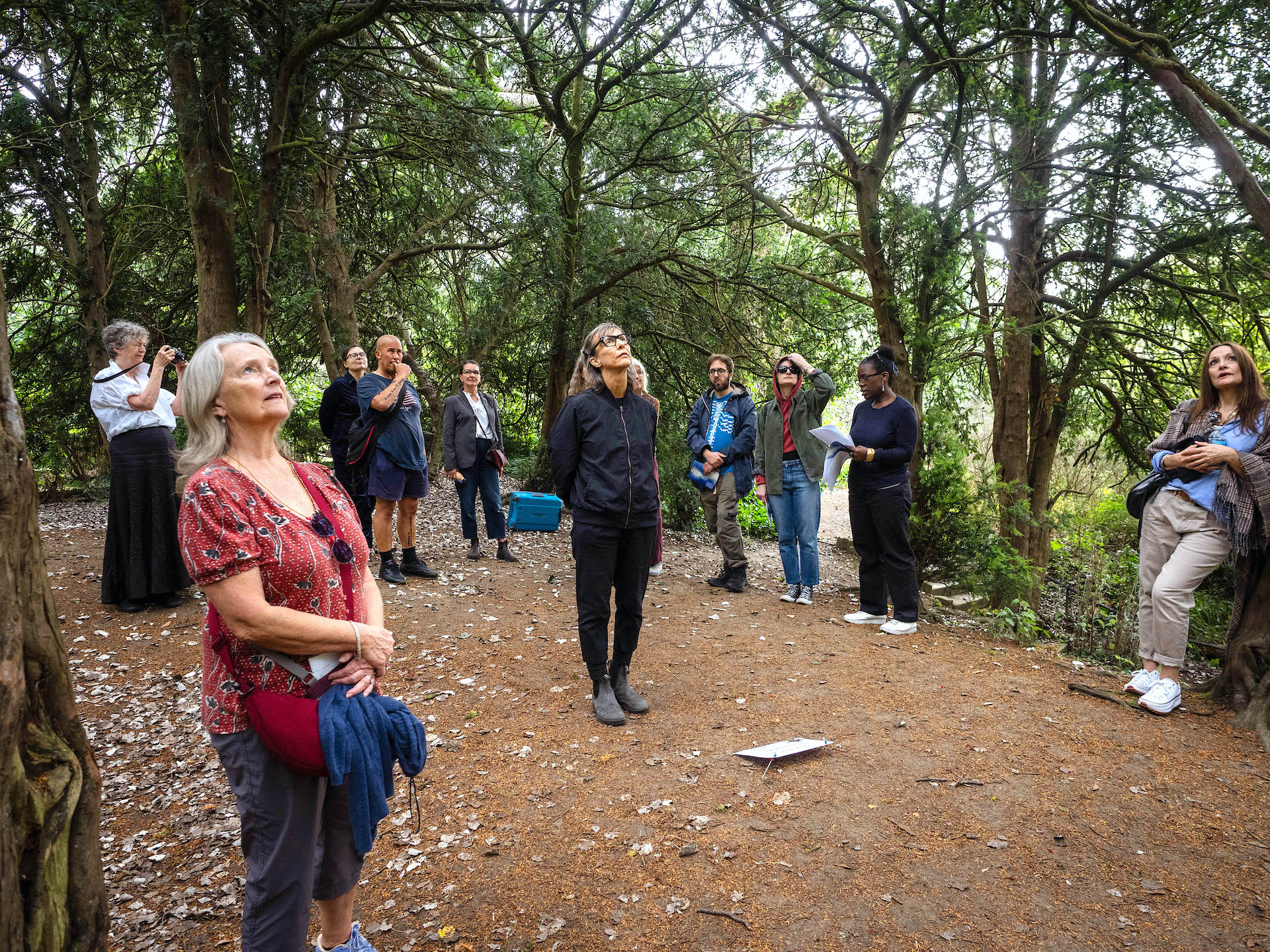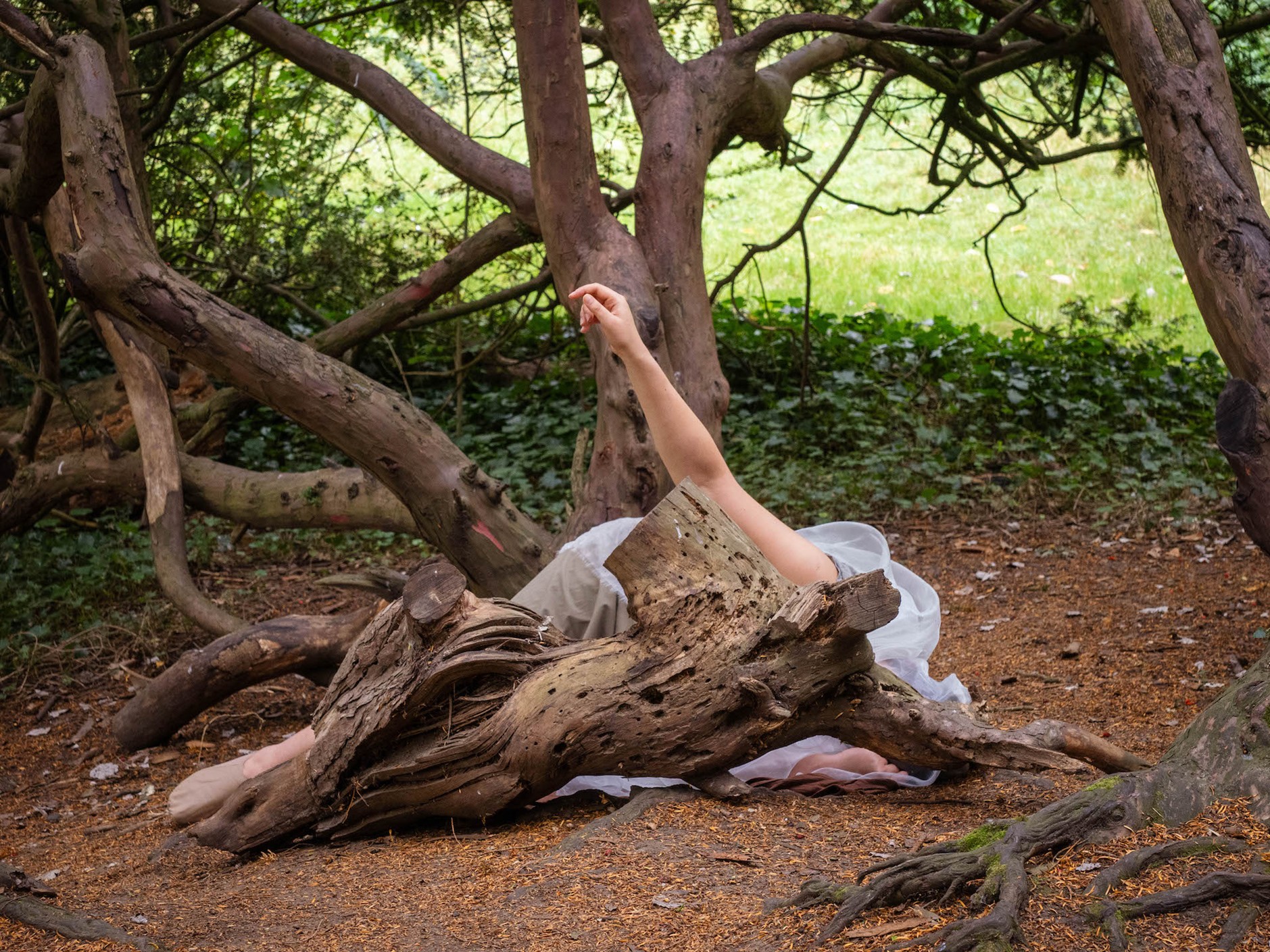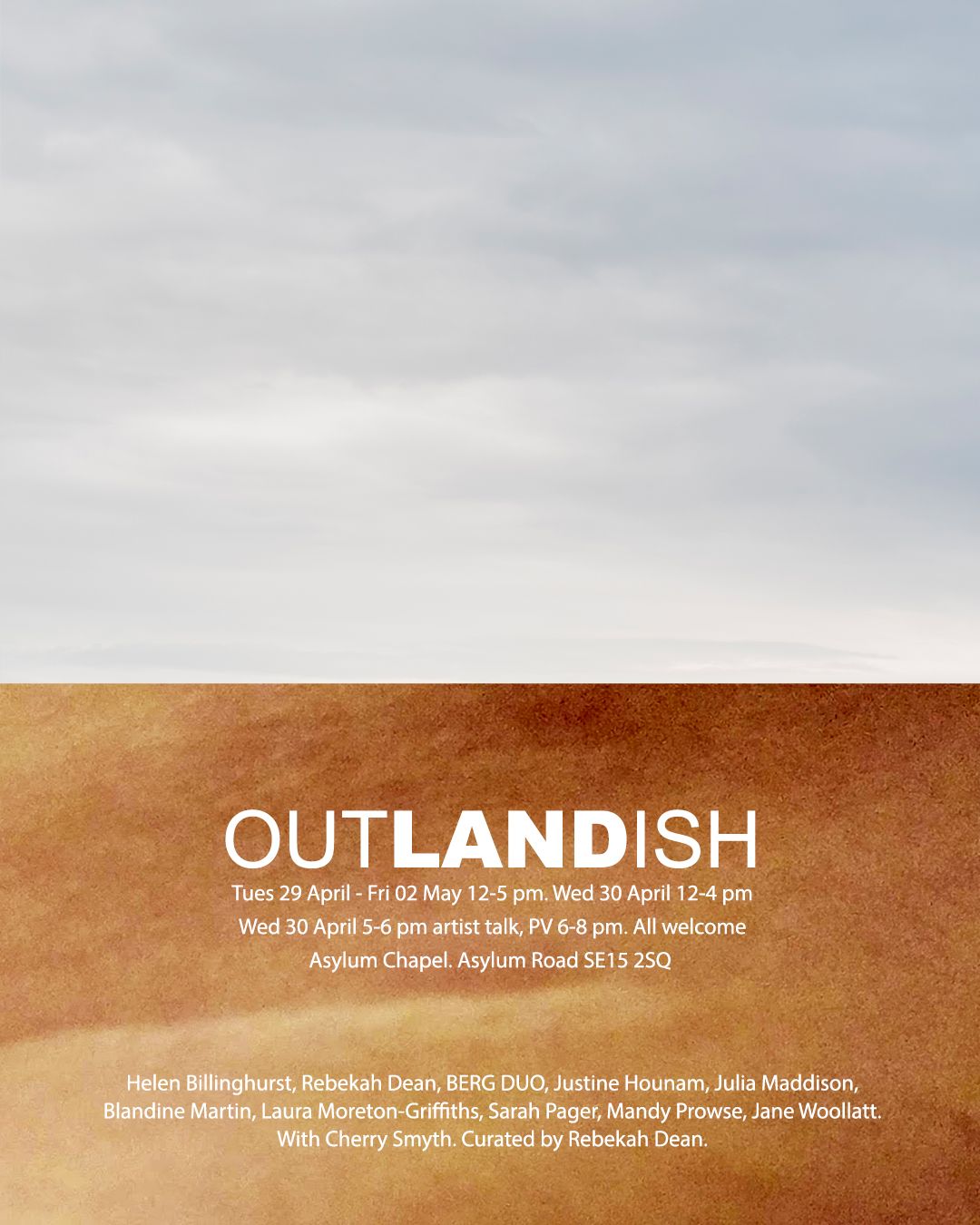Recording of ‘Landscape Futures in the Twenty-First Century: Landscape Leaders in an Intergenerational Dialogue’
On 5th December 2024, the Landscape Research Group, in collaboration…
By Rebekah Dean

The Sculpture Trail, The Sky is Moving Sideways, was first conceived as a local response to COVID during the pandemic. It was especially curated for the Grade 2 listed, mid-Victorian museum building Stephens House & Gardens in Finchley, and gathered artists and local communities back into the cultural arena, as the UK continued to navigate the risks and uncertainties of social distancing. Since that first response, the trail has continued to work with local communities, whilst remaining a testing ground for artists exploring concepts on resilience and transformation, within the context of landscape.
The 2024 trail adopted a focus on Walking and Women Artists and was funded by The Arts Council England, in partnership with Stephens House & Gardens. Twelve national and international artists were selected to pursue notions on transient and nomadic states, through the presentation of ephemeral and impermanent artworks that challenged the landscape, and the elements, within the managed grounds at Stephens House & Gardens. Due to the strict restrictions controlling the planning and management of a historic UK Grade II listed building, all new trail artworks had to be created from ephemeral materials and installed either with the support of local tree surgeons or by the artist themselves, none of the artworks could become fixed. The only permanent sculptures existing in the gardens, were two sculptures by male artists, which had been commissioned pre-COVID.

Stephens House & Gardens nestles behind a busy urban high street, the sheltered and managed “gardenesque” landscape, is overlooked by the 19th century white mansion house. If one was walking down the high street, unaware of the landscaped garden’s existence, it would not be a site that was easily discoverable because of its walled and secluded architectural design. Between the main house and the extensively designed garden landscape, the site references a rich history comprising in parts of Gothic architecture and uniquely designed wooded walking areas, in a privately managed and protected landscape, that is open to the public.
My own connection with the venue came from a six-month Artist residency leading ‘contemplative walks’ with parents and their babies, between 2017-18, and which was followed up by the walking and drawing course, ‘Art for Wellbeing’, in the London Borough of Barnet. Stephens House & Gardens has also been a place where I personally have spent much time as a young mother, raising her children and enjoying nature.
The importance of the Sculpture Trail’s commitment to nature alongside the installation of the sculptures in the landscape was paramount, and as the Curator of the trail, and as a trail Artist, I wanted to explore the local public’s experience of walking in nature with others, and how the trail might have enriched their observation and attention to nature in the landscape. The venue was also looking to deliver the trail annually, rather than biennially, and wanted to learn about public response during the trail. The ‘Fun Curator’s Public Tour’ and a walk with the Artists, sort to explore visitor feedback and was publicised to recipients of the venues monthly e-newsletter, and to the wider public on the venue’s website, as a free event.

The very aim of a Sculpture Trail is for viewers to walk a considered distance in-between the artworks. Unlike a gallery space, which presents a confined interior setting, and shorter walking distances between the artworks, the sculpture trail offers the viewer the experience of walking outdoors and being in the open air. In a piece of research previously commissioned by the venue, known as ‘Dwell Time’, (Keenan 2019) it concluded that visitors who dwell or linger for two hours or more in the gardens, found it conducive to experiencing feelings of happiness. With a walk time of fifteen minutes at a steady pace, or twenty, at a more convivial gait, regular visitors to the gardens can explore the ground’s unique arboretum, observe the Bothy walled garden, watch giant Carp in the pond, and see various designated wildlife areas. The activity of walking keeps the trail visitor actively on the move, with the promise of a new creative experience, on arrival at each sculpture, in many ways, a sculpture trail performs elements of ‘wellbeing’. (Aked, Marks, Cordon, Thompson 2008). In a 2022 piece of research commissioned by the Arts and Humanities Research Council it explored how walking made people feel during the pandemic and concluded that walking was good for wellbeing because it created attachment to place, and a setting for conversation, inspiration and creativity. (Heddon, Qualmann, Wilson, O’Neill, Rose 2022)
The ‘Fun Curator’s Public Tour’ and walk with the artists enticed the viewer to wander the landscape from one sculpture to the next and incorporated a walk time of just under two hours around the gardens, from start to finish. The tour featured the live performance Arboreal, by Mexican Artist, Nahelli Chavoya, and a walking score written specially for the trail, performed by Laura Moreton-Griffiths and Rebekah Dean. The walking score ‘SCULPTURE YOU’, was written for the trail by invited Swedish artists BERG DUO, Ami Skånberg, Anna Viola Hallberg.



The score became a playful and poetic way of engaging artists and the audience whilst walking the trail in between the sculptures. Identified by the duo as “a movement script”, the score was presented as a ritualised performance, which comprised of a set of instructions, to be found on the back of the free colour printed trail map or downloadable from the venue’s website. Equipped with a map, the tour encouraged visitors to remain actively on the move whilst connecting with nature and the landscape.
Anybody could perform the walking score during the tour, if they followed the set of instructions on the back of the map, this was relayed to the audience by the tour guide at the beginning of the tour, and it was also demonstrated and performed live on arrival at each sculpture, by two of the trail Artists, this became the ‘fun’ element in the ‘Fun Curator’s Tour’. The score performs an embodiment of walking and a presence with the sculptures, and opens the physical space in between the sculptures, and the embodied space of the audience.
In the last ten years there has been a wealth of publications and walking art created by artists exploring the format of the Walking Score. (Qualmann, Hind, 2015) (Morris 2019-20). During the pandemic a publication was funded by the Arts and Humanities Research Council, which presented walking scores written by Artists as a series of thirty recipes for the walking public ‘The Walkbook: Recipes for Walking & Wellbeing’ 2022) Walking Scores were primarily devised by estate agents to assess a location’s walkability, and in the US, estate agents use a walk score to influence their house sales.



All the artists responded to notions on the landscape and the transitioning elements of nature, through the development of site-specific artworks using ephemeral materials such as recycled cloth, found objects and domestic materials, within the managed grounds at Stephens House & Gardens. Three of the artworks engaged with the venue’s history of containing and controlling water through irrigation and water harvesting systems, originally supplying the Bog Garden, and which the venue is currently seeking to refurbish.
The partnership with the venue’s chosen tree surgeons Tree Matters, allowed some of the artists the opportunity to create sculptures specifically for installation into high tree locations. The Coronation Oak featured ‘Every Cloud’ by Mandy Prowse, the Middle Green Spinney grouping of high trees presented ‘Shifting’ by Julia Mallaby, and a mature Horse Chestnut tree in the Wildlife Area exhibited the expansive artwork ‘Persephone’s Escape’ by Jane Woollatt.
My own sculpture, ‘Tears of the Kingdom’ explored a relationship between landscape and the body and the concept of an apology. It was installed within a fox run, around the multiple exposed roots emanating from a single tree, on a steep and dusty mud slope, where rats and squirrels moved freely around. I wanted all those relational elements to sit alongside each other, yet at the same time allow my installation to exist. I worked intuitively with the bare roots of the tree, touching earth and the dry dusty soil, hanging onto branches, I maintained my balance throughout the install against the gravity of tree’s slope, with the company of a rat watching me from a safe distance. The installation comprised of flesh coloured felt, stitched around the roots of the tree, with two other separate branches from different trees at Stephens House & Gardens, incorporated into the installation. Pieces of felt have been tacked around the roots and loosely gathered around the alien branches. The fabric felt, which goes through many manufacturing processes of distressing and beating, is used as a metaphor for empathy and healing. Both the tree’s roots & the estranged branches are gathered up and bound together in the fabric and nestled as live forms within the comfort and protection of the tree roots. Together they resembled an androgynous body escaping from the earth’s roots.
A framed photo of an open empty hand, bound to a separate small tree trunk, sits at the top of the slope, and on the lower slope below the felt tailored roots, a dark slate stone hangs in the balance, like creature guarding space. The empty open hand and the slate stone sit in opposition, separated and at a distance, divided and never to meet. The force of the stone’s gravity remains a constant threat.
The fragility of the ephemeral sculptures on the trail, seemed to perform the fugacious element in these uncertain times of change, and how climate change has taken its toll on the gardens too. The grounds are often flooded in winter, and the waterlogged landscape becomes a duck pond. Whilst the other extreme in summer, of a previously saturated ground and sodden roots, are so overheated and bone dry, that the trees’ roots shrivel in the heat, becoming so distressed and weak, that they buckle and fall under the loss of mass, to disease and rot.

The trail was looking to examine the local public’s experience of walking in the landscape, and how it might have enriched their observation and attention to nature and the environment. I am told by the venue that many of the public who sign up for their events are usually from the local neighbourhood, and recipients of their e-newsletter.
Everyone who attended the tour including the trail Artists, was invited to respond anonymously to two open-ended questions over tea afterwards. What did you find satisfying about the tour today? And secondly, if there were any changes you would make to the tour, what would they be?
14 people booked onto the free Fun Curator’s Tour through the venue’s booking system, and eleven turned up on the day.
Out of eleven attendees these were some responses to the first question: What did you find most satisfying about the tour?
Thinking about walking and taking time to look and see the trees and the art works. I enjoyed the Artist’s Walk listening to their comments helped me think more deeply.
I found the gentle pace, the gracious setting and the opportunity to hear the artists speak about their work so rewarding. It was fascinating to be able to reflect on the pieces, and the environment, in the context of the performances as well.
…The sculptures were beautiful! I loved the experience of walking in nature to reach every spot. It was a perfect way to enjoy a moment of contemplation and art.
Viewing the pieces a second time and hearing more about the creative process was illuminating. It also made me see different aspects of the environment; in a space I know well
Relaxing atmosphere connecting art to nature.
The pace at which we went round the pieces of works. Giving us a chance to take on board the environment i.e. nature, something we take for granted.
The conversations that are going on between the work and the gardens. The freedom to roam around, the tiny droplets of rain, birdsong, artists talking about their work, inviting us in, nourishing us. The attention to grief, the joy of live art out in the open and the walking performance regulating us.
.
And in response to the second open-ended question, if there were any changes you would make to the tour, what would they be?
Most of the feedback was for no change, apart from one person, who stated that they would like the tour to be “a bit slower”.
The Fun Curator’s Tour, featuring a Walk with the Artists, provided a socially engaged, creative framework within which artists and audiences alike, could observe and reflect on their encounters with nature in the landscape, against the backdrop of a Sculpture Trail. What is interesting to note is that the performed walking score served as both a question and a provocation both to the sculptures and to the landscape, which through the audience’s own embodied engagement, and the performed ritual, challenged them, and brought them into a deeper awareness with nature and the environment.


The artworks featured in this photo essay will take on a new life in OUTLANDISH, a group exhibition at the atmospheric Asylum Chapel in London, curated by LRG member Rebekah Dean.
📅 29 April – 2 May 2025 | 12–5 pm (⏳ 30 April: 12–4 pm)
📍 Asylum Chapel, Asylum Road, London SE15 2SQ
A group exhibition of women artists exploring notions of landscape.
This show brings together women artists whose works were originally created for The Sky is Moving Sideways Sculpture Trail – artworks made to appear in the outside landscape. As these ephemeral pieces were returned to the artists’ studios, questions emerged for Rebekah: what would an inside exhibition of these ephemeral objects look like? The more she considered this question, the more she realised that what she was really thinking about was the notion of landscape, and the sacredness of landscape. Something that’s immense and boundless, bigger than us, yet also something that we carry within us. What is landscape?
In OUTLANDISH, the artists have been invited to deconstruct their original trail artworks for an exhibition within the context of a sacred space; to present new artworks from the deconstruction, as a method for thinking and discussing notions on landscape.
